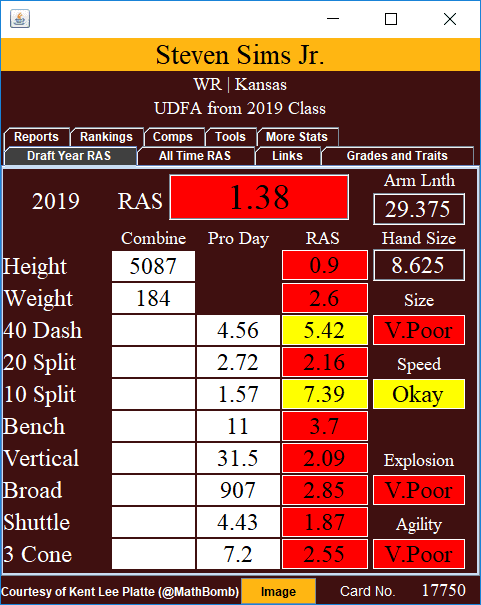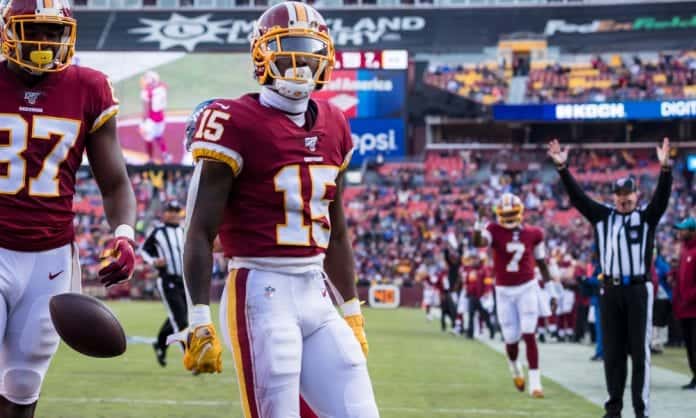The 2019 season saw numerous teams benefit from great production out of their rookie wide receivers. Teams like the Steelers, Titans, and Seahawks struck it big with the likes of Diontae Johnson, AJ Brown, and D.K. Metcalf. Then there were teams like Washington. Not only did Washington hit once on their rookie receivers, they hit twice. Third-round pick Terry McLaurin got most of the headlines and deservedly so, but more surprising was the contribution of undrafted free agent wide receiver Steven Sims Jr.
(Editor’s note: This piece was written before the news of Kelvin Harmon’s season-ending ACL injury broke.)
McLaurin and Sims were two bright spots in what was an anemic passing offense in Washington. Quarterbacks Case Keenum and Dwayne Haskins combined to turn in some of the worst performances of the season. As a team, Washington finished in the bottom-5 in attempts, completions, and passing touchdowns. McCoy and Haskins also combined to finish dead last in passing yards. Despite that, McLaurin and Sims were able to produce and stand out with their play.
Related | Filling the Washington Redskins needs in the 2021 NFL Draft
The production came early and often for McLaurin. “F1” had 5 receptions for 125 yards and a touchdown in his first game of the season, on his way to a season total of almost 1,000 yards and 7 touchdowns. It was a different story entirely for the undrafted free agent Sims. Sims had to fight and claw his way into the lineup, starting the season from the practice squad. Eventually, Sims worked his way up to a special teams contributor, then became a part-time wide receiver.
By the last quarter of the 2019 season, Sims had impressed the staff enough to see significant time at wide receiver. His hard work, and the staff’s faith in him, was rewarded to the tune of 34 receptions, 310 yards, and 4 touchdowns. Nearly all of that production came in the final four games of the season.
Now, with a new head coach in town and a new offensive system that plays to Sims’ strengths, it’s clear that Sims has earned an expanded role in the Washington offense, despite not having the athletic profile of a top-flight receiver.
[sv slug=mocksim]
Wide receiver Steven Sims’ Relative Athletic Score (RAS)
Sims was behind the 8-ball before he even got to his Pro Day testing. He came from a school, Kansas, that’s seen by most as a lower-tier Power 5 school. He came from a conference, the Big 12, that isn’t known for defense and where it’s comparatively easy to put up big numbers.
Yet, despite that, Sims’ numbers weren’t astounding. In four years with the Jayhawks, Sims never topped 1,000 yards in a season, and in his best season, he registered 72 receptions and 7 touchdowns.

The athletic testing at Sims’ Pro Day was the nail in the coffin for his draft prospects. Measuring at just a shade under 5’9” and 184 pounds, Sims garnered “Very Poor” marks in the size category, which comes as no surprise. What was surprising was how poorly Sims fared in the other categories that make up RAS.
Sims’ best category was speed, and even in this category, his testing left a lot to be desired. His 4.56 40-yard dash time was only good for a 5.42 RAS score, and does not bode well for a receiver of Sims’ size. Sims didn’t have the explosion or agility scores to save him either, posting a “Very Poor” grade in each category.
Undersized, not particularly fast, poor agility and explosion, and less-than-impressive stats is a recipe for going undrafted. But as Sims showed in his rookie season with Washington, a poor RAS score and going undrafted is not a death sentence for a player’s NFL dreams. Sometimes, there’s more than meets the eye, and Sims has shown he can transcend athletic testing and raw stats.
How does Sims win?
If Sims wasn’t particularly productive in college and isn’t a good athlete, where did his late-season surge come from? What did Washington see in Sims that other teams missed, and how did he find consistent success over the last quarter of the season? The short answer is that you can’t measure heart. Sims put in the work to go from an undrafted free agent, up through the practice squad ranks, to a key contributor down the stretch for Washington. Sims simply has the determination to succeed.
The long answer, of course, a bit more complex. First, it comes down to a difference between testing and “football skills”. Sims athletic testing was poor, but the product he puts out on the field tells a different story. Sims isn’t the fastest athlete in the league. Nor is he the most agile or explosive. But I believe he’s significantly better in all three of those aspects than the RAS score would indicate.
The other, perhaps more important, factor in Sims’ late-season success is that Washington did a great job in manufacturing positive situations for Sims. Washington’s offense did this by consistently putting Sims in stacked sets and sending him in motion. This allowed Sims, who is faster and more explosive on tape than his RAS indicates, some measure of separation from the outset of a play, mitigating some of his athletic shortcomings.
What to expect in year 2
It wasn’t easy for Sims to see the field in Washington. He had to earn it every day, and he came through. So what can we expect from the wide receiver in year 2? Sims has earned an expanded role in a new Washington offense. Even in an anemic offense last season, Sims put up numbers that, when projected over a 16-game schedule, pan out very nicely for a number 2 receiver.
The offense in Washington should see a significant uptick from where it was in 2019. Quarterback Dwayne Haskins should have firm control of the offense and see significant development from his rookie season. The change in coaching staff should also be a sizable boon for Sims. The wide receiver’s role in Washington’s new offense will likely be akin to the role Curtis Samuel has filled in Carolina.
Samuel saw 105 targets for the Panthers last season, putting up just over 600 yards and 6 touchdowns. If Sims can see that many targets and do better than Samuel’s 51% catch percentage, those numbers should be attainable. But is that Sims’ ceiling? Just how high can the receiver climb?
I posed this question about Sims’ production to my Twitter followers and fellow PFN writer — and resident Washington fan — Matt Valdovinos had this response:
60-750-8 with two return touchdowns and 150 rushing yards and another touchdown.
— Matt Valdovinos (@MVScouting) July 9, 2020
If Sims can get the kind of targets Samuel saw in the Panthers offense, those numbers should be within reach. However, there’s going to be significant competition for targets in the improved Washington offense. Kelvin Harmon should be able to see the field more in year two than he did as a rookie. Washington also brought in rookies Antonio Gandy-Golden and Antonio Gibson to further bolster the lackluster passing offense.
Whether there’s going to be enough targets to go around for Sims to hit that ceiling is debatable. What isn’t debatable is that Sims is a wide receiver who has absolutely earned an expanded role in the 2020 season.

